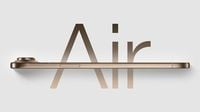Apple is gearing up to revolutionize its iPhone lineup this fall, with the anticipated launch of the iPhone 17 series promising significant upgrades across charging technology, design, camera capabilities, and performance. Industry insiders and regulatory filings reveal that alongside the sleek new "iPhone 17 Air," Apple is preparing to introduce a next-generation MagSafe charger incorporating the Qi 2.2 wireless charging standard, which could dramatically speed up wireless charging and enhance user experience.
Recent images obtained from Taiwan's National Communications Commission website, as reported by 91mobiles, showcase new MagSafe charger model numbers A3502 and A3503 that support the Qi 2.2 standard. This is a marked leap from the current Qi 2.0 standard, which caps wireless charging at 15 watts. The iPhone 16 series, except for the 16E, already supports 25 watts with a new MagSafe charger released last year. Qi 2.2, however, could enable charging speeds up to 50 watts, potentially halving the time it takes to wirelessly charge an iPhone 17.
But the benefits of Qi 2.2 extend beyond just speed. Enhanced magnetic alignment means the iPhone will snap onto the charger more precisely and quickly, improving charging efficiency and reducing heat generation, a common concern with fast wireless charging. The new standard is also backward compatible, supporting iPhones as old as the iPhone 11, which means users can enjoy improved charging performance even without upgrading their handset immediately.
This timing aligns perfectly with Apple’s annual Worldwide Developers Conference in early June 2025, where software updates are typically announced, and sets the stage for a September unveiling of the iPhone 17 lineup. While not all models may support the full 50W charging speeds, the introduction of new MagSafe hardware suggests that at least some devices in the series will leverage this technology fully.
Meanwhile, the iPhone 17 Air is shaping up to be a remarkable addition to Apple’s portfolio. Expected to be the thinnest iPhone ever, it will measure just 5.5mm at its slimmest point (though up to 9.5mm including the camera bump). The device will sport a 6.6-inch OLED display with Face ID and possibly a smaller version of the Dynamic Island feature. While ProMotion support for a 120Hz refresh rate is debated, the phone will run on an A19 chip rather than the more powerful A19 Pro found in higher-end models.
Camera-wise, the iPhone 17 Air will feature a single 48-megapixel rear camera on a new elongated camera bar and a 24-megapixel front camera, doubling the resolution from previous models. However, it will have only one speaker located in the earpiece, lacking a bottom speaker, and will rely solely on eSIM technology, eliminating the physical SIM card slot worldwide. Connectivity will be bolstered by Apple-designed Wi-Fi 7 and C1 cellular modem chips, and the phone will include a USB-C port, a high-density battery, and retain both the Camera Control and Action buttons. Notably, Apple is also reportedly planning to release a battery case specifically for the iPhone 17 Air.
At the high end of the spectrum, the iPhone 17 Pro Max is expected to launch between September 11 and 13, 2025, bringing several major upgrades over its predecessors. One of the most significant changes is the shift away from the titanium frame used in the iPhone 16 Pro Max to a more durable aluminum frame with a hybrid back panel combining glass and aluminum. This design tweak not only enhances durability but maintains wireless charging capabilities.
The camera housing will also see a redesign, moving from a square bump to a larger rectangular aluminum module. The device is expected to be slightly thicker at 8.725mm, likely to accommodate a bigger battery. The popular Camera Control button introduced in the iPhone 16 Pro Max will be retained, reflecting Apple’s commitment to enhancing user control over photography.
Under the hood, the iPhone 17 Pro Max will debut Apple’s new A19 Pro chip, manufactured using an advanced 3nm process. This chip promises faster processing speeds and improved power efficiency compared to the A18 Pro and A17 Pro chips in previous models. Complementing this is a boost in RAM to 12GB, up from 8GB in the iPhone 15 and 16 Pro Max models, ensuring smoother multitasking and future-proofing performance.
Camera upgrades on the Pro Max are poised to impress photography enthusiasts. The telephoto lens will be upgraded from 12 megapixels to 48 megapixels, making the iPhone 17 Pro Max the first in the series to feature three 48MP rear lenses — main, ultra-wide, and telephoto. The front-facing camera will also double its resolution to 24 megapixels and incorporate a six-element lens for sharper selfies and better video calls, a long-awaited improvement given the front camera hasn’t seen a significant upgrade since the iPhone 14 Pro.
TechRadar has highlighted additional camera enhancements that users hope to see in the iPhone 17 Pro series, including variable optical zoom or the addition of an extra zoom lens to enable multiple focal lengths, potentially up to 10x zoom. There’s also a desire for better AI photo editing tools, as Apple’s current AI capabilities lag behind competitors like Samsung’s Galaxy AI. Larger sensors to improve low-light performance are also sought after, though some reports intriguingly suggest the main camera sensor might shrink, something Apple fans hope won’t materialize.
On the pricing front, Counterpoint Research analysts warn that ongoing U.S. tariffs may push Apple to increase the cost of the iPhone 17 series. While Apple has absorbed these expenses in the past, the iPhone 17 could mark a shift, potentially making the latest models more expensive. In India, the iPhone 17 Pro Max is expected to launch at Rs 1,64,900, a notable rise from Rs 1,44,900 for the iPhone 16 Pro Max and Rs 1,59,900 for the iPhone 15 Pro Max.
With all these changes, the iPhone 17 series is shaping up to be a compelling upgrade for both casual users and tech enthusiasts. Faster wireless charging through Qi 2.2, a thinner and lighter iPhone 17 Air with modern connectivity, and a powerhouse iPhone 17 Pro Max with significant camera and performance enhancements represent Apple’s ongoing push to refine and elevate the smartphone experience.
As the countdown to September continues, Apple fans and industry watchers alike will be eager to see how these rumors and regulatory filings translate into real-world devices. Whether it’s the promise of lightning-fast wireless charging or the allure of triple 48MP cameras, the iPhone 17 series looks ready to set new standards in the smartphone market.


